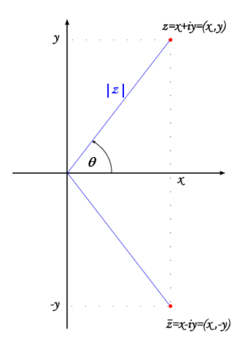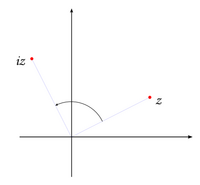This is an experimental draft. For a brief description of this project click here.
Definition
Complex numbers are defined as ordered pairs of reals:

Such pairs can be added and multiplied as follows
- addition:

- multiplication:

 with the addition and multiplication is the field of complex numbers. From another of view,
with the addition and multiplication is the field of complex numbers. From another of view,  with complex additions and multiplication by real numbers is a 2-dimesional vector space.
with complex additions and multiplication by real numbers is a 2-dimesional vector space.
To perform basic computations it is convenient to introduce the imaginary unit, i=(0,1).[1] It has the property  Any complex number
Any complex number  can be written as
can be written as  (this is often called the algebraic form) and vice-versa. The numbers a and b are called the real part and the imaginary part of z, respectively. We denote
(this is often called the algebraic form) and vice-versa. The numbers a and b are called the real part and the imaginary part of z, respectively. We denote  and
and  Notice that i makes the multiplication quite natural:
Notice that i makes the multiplication quite natural:

The square root of number in the denominator in the above formula is called the modulus of z and denoted by  ,
,

We have for any two complex numbers  and
and 

 provided
provided 

For  we define also
we define also  , the conjugate, by
, the conjugate, by  Then we have
Then we have


 provided
provided 

Geometric interpretation
Complex numbers may be naturally represented on the complex plane, where  corresponds to the point (x,y), see the fig. 1.
corresponds to the point (x,y), see the fig. 1.

Fig. 1. Graphical representation of a complex number and its conjugate
The modulus is just the distance from the point  and the origin. More generally,
and the origin. More generally,  is the distance between the two given points. Furthermore, the conjugation is just the symmetry with respect to the x-axis.
is the distance between the two given points. Furthermore, the conjugation is just the symmetry with respect to the x-axis.
Trigonometric and exponential form
As the graphical representation suggests, any complex number z=a+bi of modulus 1 (i.e. a point from the unit circle) can be written as  for some
for some  So actually any (non-null)
So actually any (non-null)  can be represented as
can be represented as
 where r traditionally stands for |z|.
where r traditionally stands for |z|.
This is the trigonometric form of the complex number z. If we adopt convention that  then such
then such  is unique and called the argument of z.[2]
The equality of two complex numbers
is unique and called the argument of z.[2]
The equality of two complex numbers  and
and  is equivalent to
is equivalent to  and
and  for certain integer k.
Graphically, the number
for certain integer k.
Graphically, the number  is the (oriented) angle between the x-axis and the interval containing 0 and z.
Closely related is the exponential notation.
If we define complex exponential as
is the (oriented) angle between the x-axis and the interval containing 0 and z.
Closely related is the exponential notation.
If we define complex exponential as

then it may be shown that

Consequently, any (non-zero)  can be written as
can be written as
 with the same r and
with the same r and  as above.
as above.
This is called the exponential form of the complex number z.[3]
It is well-adapted to perform multiplications. Indeed, for any  and
and  we have
we have

 provided
provided 
The following particular case of complex multiplication is well-know as the de Moivre formula
[4]


Fig 2. Multiplication by

amounts to rotation by 90 degrees.
Graphically, multiplication by a constant complex number  amounts to the rotation by
amounts to the rotation by  and the homothety of ratio r. In particular, the multiplication by i amounts to the rotation by the right angle (counter-clockwise), see Fig. 2.
and the homothety of ratio r. In particular, the multiplication by i amounts to the rotation by the right angle (counter-clockwise), see Fig. 2.
Complex roots
Any non-constant polynomial with complex coefficients has a complex root. This result is known as the Fundamental Theorem of Algebra. Consequently, any complex polynomial of degree n has exactly n roots (counted with multiplicities). In particular, the equation
 ,
,
where z is the variable and a a non-zero constant has exactly n solutions. They are called nth (complex) roots of a. If a is written in the exponential form,  then the n roots of a, denoted as
then the n roots of a, denoted as  , are given by
, are given by
![{\displaystyle z_{k}={\sqrt[{n}]{r}}\exp \left(i\left({\frac {\theta +2k\pi }{n}}\right)\right),\quad k=0,1,\ldots ,n-1.}](https://wikimedia.org/api/rest_v1/media/math/render/svg/e9caf2be56b4cd58fb049d43aad2aed08db18b75)
It follows that the roots form a regular n-sided polygon centred at the origin. Particularly important are the roots of unity, i.e. solutions of  .
The cubic roots of 1 (with n=3) are {
.
The cubic roots of 1 (with n=3) are { } and for n=4 we have :{
} and for n=4 we have :{ }.
}.
References
- ↑ in some applications it is denoted by j as well.
- ↑ In literature the convention
![{\displaystyle \theta \in (-\pi ,\pi ]}](https://wikimedia.org/api/rest_v1/media/math/render/svg/2742d923047f035ec3e8db8259485fda0629104b) is found as well.
is found as well.
- ↑ The equivalence of two complex numbers can be checked as in the trigonometric form case.
- ↑ It is commonly used to linearise powers of trigonometric functions in integrals.



















































![{\displaystyle z_{k}={\sqrt[{n}]{r}}\exp \left(i\left({\frac {\theta +2k\pi }{n}}\right)\right),\quad k=0,1,\ldots ,n-1.}](https://wikimedia.org/api/rest_v1/media/math/render/svg/e9caf2be56b4cd58fb049d43aad2aed08db18b75)



![{\displaystyle \theta \in (-\pi ,\pi ]}](https://wikimedia.org/api/rest_v1/media/math/render/svg/2742d923047f035ec3e8db8259485fda0629104b)